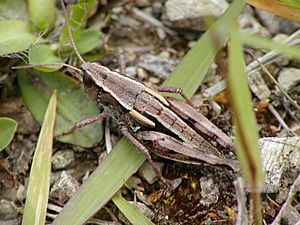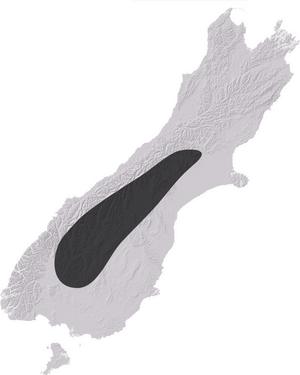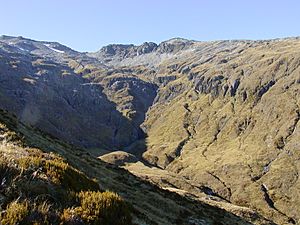Sigaus australis facts for kids
Quick facts for kids Sigaus australis |
|
|---|---|
 |
|
| A female Sigaus australis | |
| Scientific classification | |
| Kingdom: | |
| Phylum: | |
| Class: | |
| Order: | |
| Family: | |
| Genus: |
Hutton, 1897
|
| Species: |
S. australis
|
| Binomial name | |
| Sigaus australis (Bigelow, 1967)
|
|
 |
|
| The distribution of Sigaus australis in New Zealand | |
The Sigaus australis is a special type of grasshopper. It is the most common alpine grasshopper found in New Zealand. "Alpine" means it lives in high mountain areas, often above the tree line.
This grasshopper lives in the southern part of New Zealand's South Island. It was first described in 1897 by a scientist named Frederick Hutton.
Like other New Zealand mountain grasshoppers, S. australis has a life cycle that lasts 2 or 3 years. What's really cool is how they survive the cold! These grasshoppers can actually freeze solid at any stage of their life, at any time of the year. They can then thaw out and continue living! Adult females are quite large for a grasshopper, growing up to about 26 millimeters (about 1 inch). The group of grasshoppers called Sigaus is endemic to New Zealand. This means they are only found there and nowhere else in the world.
Where They Live
You can find Sigaus australis in the southern half of the South Island. This includes the Otago and Canterbury areas. They live as far south as the Kawarau River and as far north as the Torless Range.
These grasshoppers love tussock grasslands. These are areas with clumps of tough grass. They usually live at heights between 1,300 and 1,700 meters (about 4,200 to 5,600 feet) above sea level. However, they can sometimes be found as low as 200 meters (about 650 feet) or as high as 2,000 meters (about 6,500 feet).
Scientists have studied their DNA. This research suggests that S. australis might actually be several different types of grasshoppers. Some types live in small, specific areas, while others are found more widely.
What They Look Like
The S. australis grasshopper has very small wings, only about 2 to 4 millimeters long. Because their wings are so small, they cannot fly. Most New Zealand grasshoppers are also flightless.
These grasshoppers are very good at hiding. This means they blend in with their surroundings. They are usually earth tones like brown, grey, or green. This helps them match the plants and rocks where they live. It makes them very hard for predators to spot!
Images for kids





